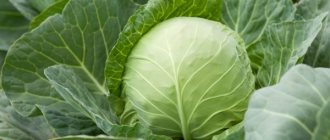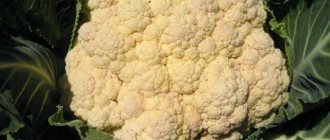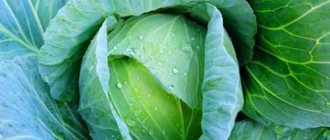Gardeners rarely plant Chinese cabbage. For those who decide to try an unusual type of cabbage, Bilko F1 is perfect. It has many advantages: it is not afraid of diseases, ripens early, has excellent taste.
| Landing location | Ripening time | View | Purpose | Origin | Maturation period | Weight |
| Greenhouse, Open ground | Early ripening | Beijing (salad) | Fresh, Long-term storage, Pickling, Cooking | Hybrid | 60-70 | 1,5-1,7 |
Differences from other varieties
This variety belongs to the mid-early variety, the ripening period is from 65 to 75 days. It has good yield and is resistant to diseases . Bilko is immune to many races of clubroot, downy mildew, fusarium and mucous bacteriosis.
It is distinguished by excellent transportability and does not lose its properties and presentation during transportation. It can be stored fresh for quite a long time – from 2 to 6 months.
Reference! The seeds of the Bilko variety, like many hybrid ones, are processed and ready for planting; there is no need to soak them or perform other manipulations with them before sowing.
Cabbage on the window
Some Russians who do not have a plot of land are interested in whether it is possible to grow full-fledged heads of cabbage of the Bilko F1 variety in an apartment. We hasten to make them happy. The main advantage of growing vegetables at home is obtaining fresh produce throughout the year.
Let's look at the features of agricultural technology:
- Preparing fertile soil. You can use store-bought soil mixture. Pour it into a container with a volume of at least 500 ml.
- We spill the soil with hot water and cool it to room temperature.
- We make a small depression of 0.5 cm and sow 3 seeds in each container.
- Shoots appear after 4 days. When the plants grow, we select the strongest seedling and remove the rest.
Caring for Chinese cabbage of the Bilko variety at home comes down to timely watering, fertilizing, temperature and light control.
Technology for growing Chinese cabbage:
External characteristics
The fork is formed rectangular and has a rounded shape. The average weight is from one to two kilograms . The density of the head of cabbage is average, and the stalk inside is short.
The leaves are ovoid, turned in the opposite direction, pimply, green in color.
When cabbage reaches ripeness, the leaves below become yellowish-white and on top become a rich light green color.
Description of cabbage variety
As this vegetable crop matures, it forms a dense, barrel-shaped head of cabbage, located vertically on the beds. The leaves of Bilko F1 cabbage are medium sized, glossy, obovate in shape. The surface of the leaf plate bubbles strongly. The color of the leaves is bright green.
The head of cabbage narrows at the top. The inner stump is of medium length, so after cleaning the cabbage leaves virtually no waste. With the onset of technical maturity, the upper part of the leaves acquires a light green color, while in the lower part the cabbage becomes whitish-yellow. When cut, the head of cabbage has a yellowish tint.
The weight of a ripened head of Bilko F1 cabbage averages 1.5-1.7 kg, however, there are specimens weighing 2 kg. The taste of the variety is excellent.
Step-by-step instructions for the gardener
Upon landing
Seedling
In order to get an earlier harvest, you need to plant Chinese cabbage seedlings in open ground. You need to sow seeds for seedlings in April .
- Before planting, the soil is spilled with boiling water and potassium permanganate. This will protect the cabbage from such a disease as black leg.
It is better to plant the seeds immediately in a separate cup or cassette, immersing them in the soil about half a centimeter.- After this, place the containers in a room with a temperature of at least 20-24 degrees. Sprouts appear after 4 days.
Now Chinese cabbage needs to get a lot of light. You need to install it on a well-lit window. If there is little light, you need to create artificial lighting. Seedlings must be fertilized with urea and wood ash as they grow, and watered in sufficient quantities.
Open ground
After 3-4 leaves appear on the seedlings, they are planted in open ground. Before transplanting, the soil needs to be fertilized . For 1 sq. m recommended:
- compost – 5 kg;
- dolomite flour – 150 g;
- wood ash - 4 tbsp.
Seedlings are planted at a distance of 30 cm, leaving about half a meter between rows.
Care
Caring for Chinese cabbage is easy. Bilko is resistant to major diseases that affect cruciferous plants , but is susceptible to the formation of flowering arrows under unfavorable conditions.
The main reasons for this:
- too low or high temperatures at the beginning of plant growth;
- damage to the root system during transplantation;
- daylight hours are too long (more than 13 hours);
- cabbage bushes are too close to each other.
In addition, it is necessary to loosen the soil in time, remove weeds, apply fertilizers before planting; the harvest will not be high on depleted soil.
Important! When planting Chinese cabbage, it is necessary to observe crop rotation; the crop can be planted in the same place only after 3-4 years.
For cleaning
The top leaves of Chinese cabbage are cut off and used to make salads. A ripe head of cabbage is cut off along with the stalk. Beijing cabbage Bilko is used for preparations and is stored well, because... The head of this variety is covered with leaves, and does not spoil for a long time during storage.
By reproduction
This variety is equally productive both when seeds are planted in the ground and when grown as seedlings. It will not be possible to grow and collect seeds of the Bilko variety yourself, because... the necessary properties will not be saved. Specialized varieties must be purchased from trusted manufacturers.
Harvest storage
Bilko cabbage is fermented or stored fresh . Heads of cabbage are selected that are not caught by frost and not affected by fungal diseases and have no damage.
For storage, cabbage can be wrapped in cling film or left open. It is placed in a box in one layer and placed in the cellar. The humidity there should be 95-98%, the air temperature from 0 to +2 degrees. If the indicators are higher, the cabbage may begin to sprout. Another way to store cabbage heads is freezing.
When storing Chinese cabbage in the cellar, its proximity to any fruit is unacceptable.
Landing
Seeds are sown for seedlings in April, and in the ground when the temperature stabilizes. Prepare soil with peat and humus, well drained. The mixture, prepared independently, is calcined in an oven at +100 degrees or spilled with a hot solution of potassium permanganate.
The sowing depth is no more than 0.5 cm. The crops are moistened and germinated at +20–24 degrees. When the seeds germinate, slightly reduce the temperature. Seedlings are kept in good light.
Planted in the ground in the phase of 3–4 true leaves. A place for planting is chosen with loose nutritious soil, not necessarily well lit: excess light harms Chinese cabbage. Optimal predecessors: tomatoes, potatoes, cucumbers, peppers, eggplants, pumpkin, zucchini, legumes, onions or green manure. It is not recommended to plant after other types of cabbage or radishes.
Plantings cannot be thickened. Follow a pattern of 30 by 60 cm or more.
You can sow the hybrid seeds directly to a permanent place. They are planted at the same depth, but denser - with a gap of 5-10 cm between plants and with row spacing of 60 cm. With the emergence of seedlings, thin out if necessary. Seeds do not have 100% germination.
Analogs
The Manoko F1 variety has characteristics similar to Bilko. This is an early ripe cabbage, inferior in weight to a head of cabbage - up to 1 kg, but also retains its properties and appearance well during transportation and storage. Like Bilko, it is resistant to common diseases. Quite popular varieties for fresh use:
- Richie.
- Hydra.
- Beijing broadleaf.
- Stonefly.
For storage and fermentation, the following would be more suitable:
- Roller coaster F1.
- Wineglass.
- Nika.
- Russian size.
Climatic growing conditions
The Asian plant is suitable for central Russia, but only when planted at a time of year with long daylight hours. The suitable temperature range for normal cabbage growth is 13-20 degrees. Lighting must be regulated - with heat-loving vegetables, it does not tolerate excessive exposure to the sun.
Cultivation of vegetables in Siberia and the Urals
Hybrid varieties of Chinese cabbage for Siberia are planted in greenhouses; only when it gets warm (+18 degrees) can the plant be transferred to open ground. For the climatic conditions of the Urals, those varieties of crops that take root well in Siberian weather are suitable:
- Richie F1. A hybrid variety that is not susceptible to bacteriosis. Heads of cabbage with very strong density weigh approximately 2.5 kg. The heads are not stored for a long time, so they are used only in salads;
- Nika. An early hybrid that does not undergo clubroot. The waxy leaves are slightly wrinkled but juicy. Propagated by seeds and by placing seedlings in open ground;
- Khibinskaya. Cultivation in Siberian conditions is justified by the rapid growing season in beds (40-50 days) and in greenhouses (25 days). Cylindrical heads of cabbage develop optimally with short daylight hours;
- Northern beauty F1. It is resistant to shoots and ripens early - the growing season is about 55 days. The dense, barrel-shaped heads weigh approximately 2.8 kg. The leaves are rich in proteins, carbohydrates, pectin, and are resistant to rotting;
- Orange tangerine. Sown during the summer season. Early ripening variety - heads of cabbage are formed after 40 days. Due to the good harvest at low temperatures, it can be planted in Siberian conditions;
- TSHA 2. A productive variety with large light green leaves;
- Beijing Express. It ripens later than the early varieties presented, but is optimally suited for growing in beds and greenhouses. Adapted to unfavorable climates, it produces light green heads weighing 2 kg.
For planting in the Siberian and Ural climates, it is recommended to choose Peking, which ripens earlier. A crop that bears fruit before the beginning of autumn is not subject to frost or disease and is suitable for all-season preparation of salads.
What kind of Chinese cabbage is grown in the Moscow region?
The entire line of Beijing varieties for the Moscow region was developed by breeders taking into account the climate and soils of the region. Gardeners in the Moscow region, with sudden changes in temperature and moderate coolness, cultivate several types of Chinese cabbage - very early and late:
- Victoria. The early type (vegetation period is only 50 days) is distinguished by dense, long and slightly convex heads of cabbage. The succulent, fresh-tasting foliage is used in salads. Heads of cabbage can be stored for a very long time - almost 90 days;
- Russian size. The hybrid variety is resistant to adverse weather. The growing season is about 80 days. With proper agricultural practices, a late-ripening head of cabbage reaches a weight of 4 kg;
- Cha-Cha. Suitable for growing in central climates. Planted by seedlings or seeds, it is characterized by an average ripening speed of 55 days. The heads weigh about 2.8 kg;
- Yuki. An early ripening variety that quickly germinates under the film. Cabbage is resistant to diseases and is transported without damaging the head;
- Pomegranate. A high-yielding variety with dense dark green heads weighing 2.5 kg. Garnet is stable to necrotic formations;
- Hydra. A medium-ripening crop (55 to 60 days) produces half-open heads. Wrinkled dark green heads of cabbage do not last long;
- Stonefly. Leafy early ripening Peking - 35 days are enough for a complete growing season. The core is quite juicy, so it is suitable for making salads;
- Wineglass. The growing season is 70 days, but the crop can only be grown in greenhouses. Elliptical heads of cabbage weighing 2 kg are dense, painted in a bright green shade.
When cultivating Chinese cabbage in the Moscow region, it is important to take into account the climatic features of the region. Most varieties do not take root in transitional climates, so it is advisable to germinate seedlings in a greenhouse
Diseases and pests
During the growing season, it is unacceptable to use any pesticides to control pests; therefore, to protect against pests, wood ash is used, which must be used to dust the leaves and soil. In addition to it, salt, dry mustard, and ground red pepper are used. Slugs and caterpillars are best removed by hand.
Since Bilko is a hybrid variety, resistant to major diseases, with proper care there is no need to use chemical treatments. The seeds of this Chinese cabbage are treated with the fungicide Tiram, which creates additional protection against various types of damage.
Growing and care
Plants are watered generously at the roots with warm water. To regulate moisture, the soil is mulched.
Plantings are covered from light. You need no more than 13 hours of daylight, otherwise flower shoots will form. Arcs are built over the beds and covered with dark non-woven material.
It is impossible to feed during growth - the leaves are prone to the accumulation of nitrates. Use only homemade fertilizers: wood ash, yeast.
Peking cabbage can be grown at home on the windowsill in containers of 500 ml in volume.
Several interesting recipes
Pickled with hot pepper
For preparation you need:
- cabbage – 1 kg;
- tomatoes – 1 kg;
- hot pepper – 2 pcs;
- garlic – 8 cloves;
- salt – 50 gr.
Cooking process:
Wash the cabbage well, chop coarsely, add salt, mix well and put under pressure for a day.- Next, you need to drain the brine, squeeze out the cabbage with your hands and rinse.
- Pass thoroughly washed tomatoes through a meat grinder.
- Finely chop the garlic and pepper and add to the tomatoes.
- Add the resulting tomato mass to the cabbage, mix well and place under pressure for another day.
- Place the snack in clean, dry jars and store in the refrigerator or cellar.
Other varieties of Chinese cabbage can be found on our website. Read about Cha Cha Cha and the red Pekingese.
Delicious salad for the winter
Ingredients:
- Chinese cabbage – 1 kg;
- bell pepper – 1/2 kg;
- apple cider vinegar – 100 ml;
- onion – 1/2 kg;
- hot pepper – 1 piece;
- water – 1200 ml;
- salt – 40 g;
- sugar – 100 gr.
Cooking sequence:
- Pour water into a saucepan, add salt and sugar, let it boil.
- Pour vinegar into boiling water and boil for another 15 minutes.
- Coarsely chop the Beijing cabbage.
- Chop the onion into rings.
- Cut the bell pepper into strips.
- Place the vegetables in clean, dry jars, adding hot pepper.
- Pour the boiling marinade into jars, roll up and put under a fur coat.
When choosing Chinese cabbage for planting, it is important to pay attention to the variety and its characteristics . Bilko is resistant to diseases, high yield, good taste, in addition, it is stored fresh for a long time, retaining all its beneficial properties.
Soil Features
Beijing cabbage Bilko F1 likes well-fertilized, slightly acidic soils with a high nitrogen content. This microelement is necessary for the vegetable to grow green mass. Therefore, before planting cabbage, add the following to the soil for each square meter:
- compost from 4 to 5 kg;
- dolomite flour 100 or 150 grams;
- wood ash up to 4 cups.
Warning! During the growing season, Beijing Bilko is not fertilized because nitrates accumulate in the leaves.
If you buy a vegetable at the store, be sure to soak it in cold water before cutting it for salad.
To sow seeds or plant seedlings of Bilko cabbage, choose beds previously occupied by cucumbers, garlic, potatoes or onions. But cabbage is not planted after relatives of the Cruciferous family, since they not only have common insect pests, but also diseases.
Advice! To get a good harvest, it is necessary to use crop rotation, because cabbage can only be planted in the “old” place after three or four years.
Growing Chinese cabbage in open ground
"Pekingka" can be grown both in open ground and in a greenhouse. Each method has its own characteristics.
Chinese cabbage grows well in open ground. Moreover, in the open air and with good lighting, much less nitrates accumulate in it. True, it has one feature that jeopardizes a good harvest. Due to sudden changes in temperature, Chinese cabbage immediately begins to bloom.
The first shoots of Chinese cabbage appear within a week
Landing
The first planting in open ground should begin in April. It is better to start the second landing on the 20th of July. By the way, by the end of July, garlic is usually harvested from the beds. Planting Chinese cabbage in its place is a great idea.
During the day, it is better to cover the bed with film, lifting it only for watering. The distance between plants should be:
- for leaf form - 20 cm between rows and the same between plants;
- for the cabbage form - 35 cm between rows and 25 cm between plants.
For better lighting and ventilation, it is useful to plant plants in a checkerboard pattern.
Chinese cabbage will grow well after potatoes, carrots, onions, garlic and legumes. She does not like acidic soils, which means it is better to lime the soil in the garden bed. Seeds need to be planted in moist soil.
Watering
Chinese cabbage requires watering. The higher the temperature, the more often it is carried out. Optimal watering is irrigation and sprinkling; drip moistening is absolutely ideal. You should not allow water to stagnate in the beds; white cabbage loves it, but Chinese cabbage does not.
You need to water Chinese cabbage in the morning or evening.
Top dressing
Chinese cabbage, like any normal plant, loves fertile soil. When planting seedlings and later, at the initial stage of setting a head of cabbage, the plant needs nitrogen. For further growth, the crop needs phosphorus and potassium.
You can feed it with a solution of bird droppings or mullein: 500 g of fertilizer per 10 liters of water. For each bush you need to take 1 liter of infusion.










